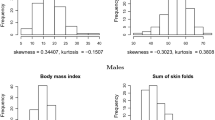Abstract
The article develops the approach of Ferro and Segers (J.R. Stat. Soc., Ser. B 65:545, 2003) to the estimation of the extremal index, and proposes the use of a new variable decreasing the bias of the likelihood based on the point process character of the exceedances. Two estimators are discussed: a maximum likelihood estimator and an iterative least squares estimator based on the normalized gaps between clusters. The first provides a flexible tool for use with smoothing methods. A diagnostic is given for condition \(D^{(2)}(u_n)\), under which maximum likelihood is valid. The performance of the new estimators were tested by extensive simulations. An application to the Central England temperature series demonstrates the use of the maximum likelihood estimator together with smoothing methods.
Similar content being viewed by others
References
Chernick, M.R., Hsing, T., McCormick, W.P.: Calculating the extremal index for a class of stationary sequences. Adv. Appl. Probab. 23, 835–850 (1991)
Fan, J., Gijbels, I.: Local Polynomial Modelling and Its Applications. Chapman & Hall, London (1996)
Ferro, C.A.T.: Statistical methods for clusters of extreme values. Ph.D. thesis, Lancaster University (2003)
Ferro, C.A.T., Segers, J.: Inference for clusters of extreme values. J. R. Stat. Soc., Ser. B 65, 545–556 (2003)
Hsing, T.: Extremal index estimation for a weakly dependent stationary sequence. Ann. Stat. 21, 2043–2071 (1993)
Laurini, F., Tawn, J.: New estimators for the extremal index and other cluster characteristics. Extremes 6, 189–211 (2003)
Leadbetter, M.R.: Extremes and local dependence in stationary sequences. Z. Wahrscheinlichkeitstheor. Verw. Geb. 65, 291–306 (1983)
Leadbetter, M.R., Nandagopalan, S.: On exceedance point processes for stationary sequences under mild oscillation restrictions. Lect. Notes Stat. 51, 69–80 (1989)
Leadbetter, M.R., Lindgren, G., Rootzén, H.: Extremes and Related Properties of Random Sequences and Processes. Springer, New York (1983)
Nandagopalan, S.: On the multivariate extremal index. J. Res. Natl. Inst. Stand. Technol. 99, 543–550 (1994)
Smith, R.L.: The extremal index for a Markov chain. J. Appl. Probab. 29, 37–45 (1992)
Smith, R.L., Weissman, I.: Estimating the extremal index. J. R. Stat. Soc., Ser. B 56, 515–528 (1994)
Weissman, I., Novak, S.Yu.: On blocks and runs estimators of the extremal index. J. Stat. Plan. Inference 66, 281–288 (1998)
Author information
Authors and Affiliations
Corresponding author
Rights and permissions
About this article
Cite this article
Süveges, M. Likelihood estimation of the extremal index. Extremes 10, 41–55 (2007). https://doi.org/10.1007/s10687-007-0034-2
Received:
Revised:
Accepted:
Published:
Issue Date:
DOI: https://doi.org/10.1007/s10687-007-0034-2
Keywords
- Central England temperature data
- Clusters
- Diagnostic
- Extremal index
- Extreme value theory
- Gaps
- Local likelihood




